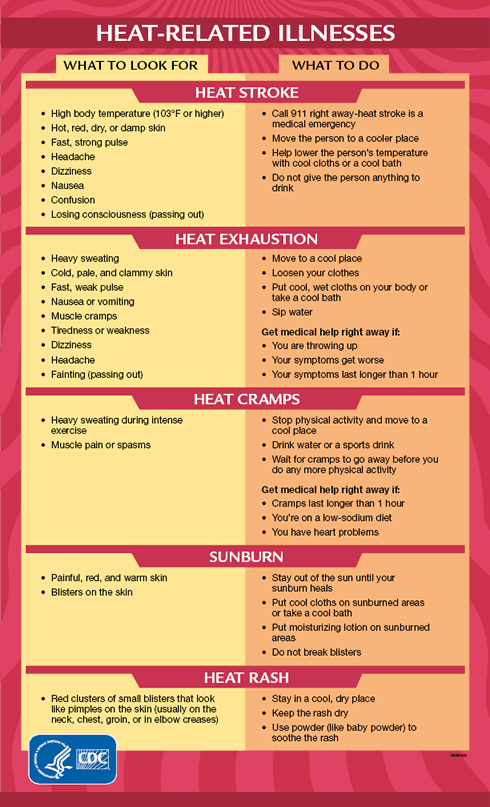Types
of and signs of hyperthermia
- Heat cramps are
painful muscle spasms in the abdomen, arms, or legs following strenuous
activity.
The skin is usually moist and cool and the pulse rate is normal or rapid.
Body temperature remains in the normal range. A low sodium level may
cause
heat cramps, but salt replacement should not be considered without advice
from a physician.
- NOTE: Use
of salt tablets to replace sodium is not recommended due to slow
absorption and the associated
risk
of: gastric irritation,
vomiting and cerebral edema.
- Heat edema
is swelling in the ankles and feet during periods of heat.
- Heat syncope
is sudden unconsciousness experienced after exertion in the heat. It is caused
by hypotension secondary to cutaneous vasodilation. The skin appears
pale and sweaty but feels moist and cool. The pulse may
be
weak, and the
heart rate is usually rapid. Blood pressure is usually less than 100 mmHg
systolic. Body temperature may be normal.
- Heat exhaustion
The skin may be cool and moist. The pulse rate will be fast and weak, and breathing will be fast and shallow. If heat exhaustion is untreated, it may progress to heat stroke. Seek medical attention if symptoms worsen or last longer than one hour.The warning signs of heat exhaustion include the following:
- Heavy sweating
- Paleness
- Muscle cramps
- Tiredness
- Weakness
- Dizziness
- Headache
- Nausea or vomiting
- Fainting
- Heatstroke is a life-threatening condition, defined as elevated core body temperature above 40C (104F), plus central nervous system involvement (delirium, decreased level of consciousness, or ataxia).
It occurs when the body becomes unable to control its temperature: the body’s temperature rises rapidly, the sweating mechanism fails, and the body is unable to cool down. Body temperature may rise to 106°F or higher within 10 to 15 minutes. Persons with heat stroke have a very high
morbidity and mortality rate so immediate medical attention is needed when symptoms first
become evident. Heat stroke can be fatal even after returning to normal temperature. Intravascular coagulation and multi-organ failure may result from the release of heat shock protein and exaggerated immune response. Acute renal failure should be anticipate. Patients that survive heat stroke often experience neurological impairment.
Warning signs of heat stroke vary but may include the following:
* fainting, often an early sign
* a core body temperature over 40C (104F)
* a change in behavior, such as confusion, combativeness, or other unusual behaviors
*
absence of sweating, despite the heat
* dry, flushed skin and a strong rapid pulse changing to a slow weak
pulse
* cool skin
due to vascular collapse
* EKG changes
consistent with heart damage
* delirium or coma
Heat-related illnesses are preventable

Instant
Feedback:
Symptoms
include: nausea, cool skin & diaphoresis, thirst, normal temperature &
pulse, careless behavior.
References
Centers for Disease Control and Prevention. (2017). Warning signs and symptoms of heat-related illness. Centers for Disease Control and Prevention. https://www.cdc.gov/disasters/extremeheat/warning.html
©RnCeus.com

